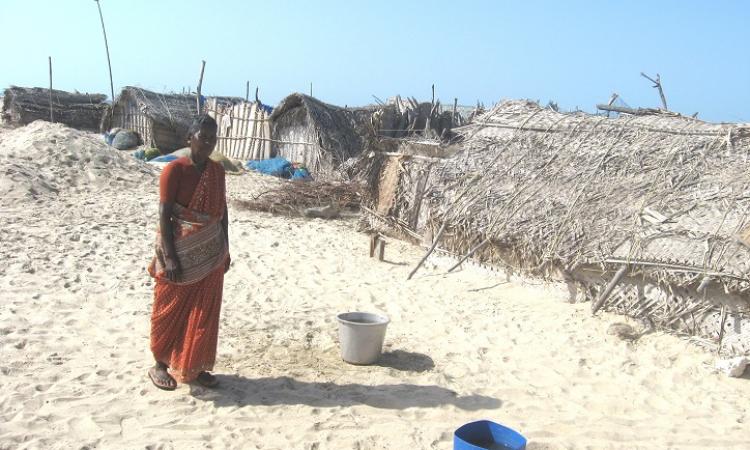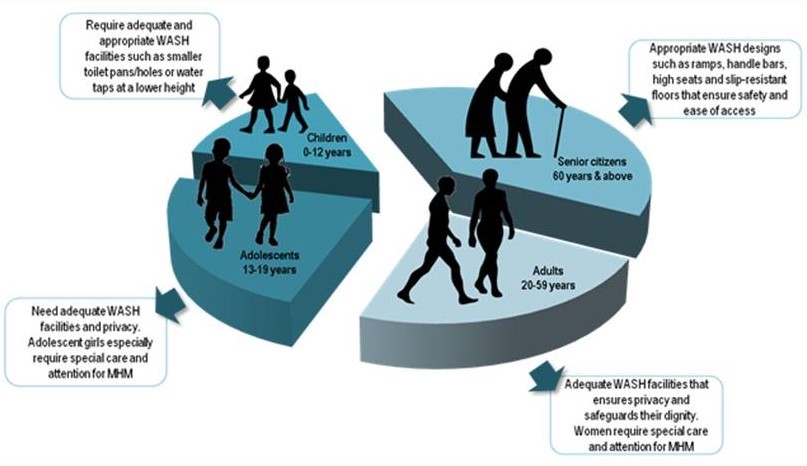
As night falls, women in Chempakaraman beach on the Pulluvila coastal belt in Thiruvananthapuram step out of their safe abode and leave for the open fields. The barking of stray dogs send a chill down their spine but still, these women brave the odds and venture into the darkness as it is an urgency. Yes, they are out to answer the call of nature and they know very well the dangers that lurk in the darkness. A few months back, an elderly woman was mauled to death by 50 stray dogs when she went out to defecate in the open at night. The lack of toilets in the community has, however, forced the women folk to gamble with their lives every night.
On the face of it, the provision of toilets is considered to be the obvious solution to this problem, but if one should ask if this is the ‘real’ solution, the answer is sadly, a "no". While a simple toilet may guarantee safety and privacy, it may not necessarily ensure comfort and suitability to one’s perceived physical needs. Sanitation, in totality, is more than just a physical structure. It is a personal space where one’s dignity and privacy are respected and safeguarded. Awkwardly, toilets often receive the least attention (often placed as far as from one's home) with a “one-design-for-all” plan for the entire family irrespective of the age and gender.

Identification of barriers to WASH services
The relationship between the water, sanitation and hygiene (WASH) barriers and appropriate service provision is linear and understanding the barriers to access the WASH services and facilities is the key to unlocking the door that stands between the provider and the user. Simply put, barriers show the way. These barriers, however, need to be sliced up and viewed from the perspective of gender, age, disability and vulnerability.
This is because, as human beings, our physical and biological needs change with age and when our needs do not align with the services provided, the results are often abortive. So, when an elderly woman or a man is provided with a common toilet, she or he will find it inconvenient to squat or will have no support to hold while squatting. They even stand a chance of falling if the floor is wet.
Considering the physical and environmental barriers faced by an elderly person, an appropriate toilet with specific features such as toilet handlebars and raised seat should be made available to them. Hence, it is imperative that WASH service provision begins with the identification of barriers for different population segments.
In every country, the provision of public goods including WASH begins at the policy level. The policy makers, including the government, set standards for the distribution of WASH services in an equitable and fair manner. These WASH policies are often in line with international commitments such as the Millennium Development Goals (MDGs) or national programmes with an overall vision to provide universal access to all.
However, with an increase in the gender and age-related violence related to WASH, one needs to ask if these WASH policies identified the barriers faced by different segments of the population and consequently, proposed appropriate strategies to overcome these barriers to ensure the realisation of WASH benefits by different population segments.
A recent study conducted by the department of management studies of IIT Madras tried to find answers to these questions by reviewing 33 national WASH policies from 10 countries drafted from the year 2000 onwards. The study analysed the extent to which a policy document includes all the three components--barriers, strategies and benefits--for each population group or what was termed as "strong robustness". Strong robustness is greatly driven by the identification of barriers and in the absence of any barriers being described for a particular population segment, the level of robustness drops.
No prioritisation of WASH needs by age-related barriers
Overall, the study revealed that national WASH policies did not prioritise the need to identify any barriers for population segments like children, adolescent boys and girls, women, men, elderly and disabled. The policies were found to be largely strategy-focused with or without the proposed WASH benefits for each of these segments. It was observed that even when barriers were identified for a few segments, they often showcased only the generic issues and failed to bring to light the individualistic obstacles faced in accessing WASH services. Consequently, these barriers did not provide a clear direction to an appropriate strategy that would help overcome them.
For example, of the 19 national policies that had covered children, only four policies had revealed strong robustness. A majority of the policies had no barriers identified for children and were predominantly strategy-focused with emphasis on WASH education and improving the demand. Moreover, these proposed strategies had no linkages to the ground realities of problems faced by children in accessing WASH services or facilities. Among children, the primary obstacle in using the toilet is the toilet itself. Children are afraid of the dark and also fear falling into the hole. Hence, child-friendly toilets need to be designed and provided.
Similarly, of the 31 policies that included women, only two policies had exhibited strong robustness. The failure to detail the barriers faced by women had steered most of the WASH policies to propose strategies that do not address the actual WASH needs of women. In one of the national WASH policies from India, the most proposed strategy for women was that of beneficiary participation; it proposed the women be included in all aspects of decision-making--drinking, water planning, implementing as well as operation and management--but the policy had no detailed description of the barriers faced by women in accessing WASH services and facilities.
Women, especially in rural areas of India, face an array of problems related to WASH. With inadequate and unhygienic sanitation and water facilities, they are susceptible to diseases such as cholera or E. coli infections. They further lack access to menstrual hygiene products and also face the challenge of safe menstrual pad disposal. In the case of adolescent girls, only one policy document (out of seven) showed strong robustness. None of the policies that had included men, adolescent boys, elderly and disabled had exhibited strong robustness.
Better identification of barriers by geography
On the positive side, it was observed that the WASH policies had well documented the barriers faced at the geographical level, that is, by the rural and the urban population as a whole. Subsequently, strong robustness was apparent among most of the WASH policies that had covered these two segments.
Public policies are key instruments to economic development and to a large extent, promote social welfare in the country. Since policy choices and decisions are promulgated by the government, they directly affect the everyday lives of a common man. It is, therefore essential that policies, especially those that address WASH, acknowledge the presence of a ‘glass curtain’ that curtails access to appropriate gender and age-related WASH services. These barriers may not be visible but it does exist at the micro or the individual level. The identification of WASH barriers is more of a means to an end rather than an end in itself.
Reeba Devaraj is a principal project officer at the department of management studies, Indian Institute of Technology, Madras. She can be contacted at reeba.devaraj@gmail.com.
For queries about this research, please contact: Evidence_research@wmail.iitm.ac.in